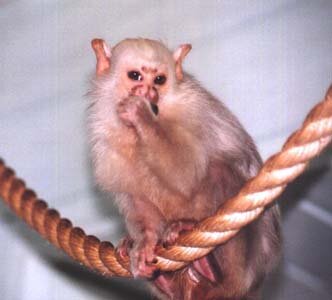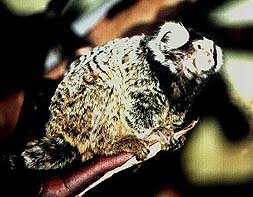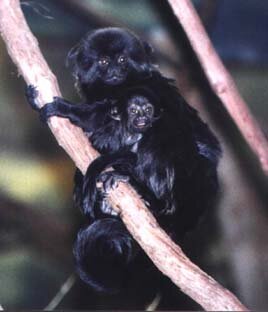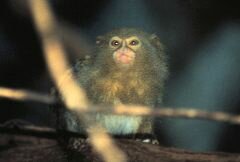MARMOSET FACTS

| Family: Callitrichidae |
Subfamily: Callitrichinae |
| Genus: Callithrix |
Species: at least eleven -- |
- argentata (silvery or bare-ear marmoset)
- aurita (buffy tufted-eared marmoset)
- flaviceps (buffy-headed marmoset)
- geoffroyi (Geoffroy's tufted-eared marmoset)
- humeralifer (tassel-eared marmoset)
- jacchus (common marmoset)
- kuhlii (Wied's tufted-eared marmoset)
- mauesi (Maues marmoset)
- nigriceps (black-headed marmoset)
- penicillata (black tufted-eared marmoset)
- pygmaea (pygmy marmoset)
-
Some of the above classifications have been disputed.
-
Goeldi's monkey (Callimico goeldii) is often grouped in with the marmosets.
Appearance:
As the above names suggest, marmosets come in a variety of styles, sizes, shapes, and colors, even within species. They are normally about 7-9 inches in length, though the smallest of them, the pygmy marmoset, is only around 5 inches. Weight ranges from 8-16 ounces, with most somewhere in the middle (the pygmy weighs around 4 ounces.) As a group, callitrichs have claws instead of nails on their hands and feet, except for their great toes, which have nails. This adaptation allows them to climb tree trunks like squirrels. Marmosets can be distinguished from the other large group of Callitrichs, the tamarins, only by the lower jaws and front teeth. Tamarins have more rounded jaws, while marmosets have V-shaped jaws to accodomate enlarged incisors which are the same size as their canines.
 Range and Diet:
Range and Diet:
Marmosets are found in central South America, predominantly in Brazil. Most of the identified species have a very small range. They are found in a variety of forest habitats. Their diets consist of fruit and animal prey, and they use their enlarged lower incisors to extract exudates (gums, resin, and sap) from trees.
Behavior and Social Structure:
Marmosets live in larger groups than tamarins, with an average group size of 9. They are all diurnal and arboreal. The social structure of all the marmoset species is not known. They are often multimale-multifemale, but not always. Pygmy marmosets live in monogamous pairs and family groups. Some marmosets have been found in association with tamarins or cebids. They communicate by a variety of vocalizations, many of which sound bird-like, and by scent marking. Several marmoset species have not been well-studied, and there is still much to learn.
 Reproduction and Lifespan:
Reproduction and Lifespan:
Females normally give birth to twins. Young are often raised communally, with only dominant females breeding. The infants place a high energy demand on their mother, being about 14-24% of her body weight. This may have given rise to the cooperative breeding system. Fathers are very involved in child-rearing, often carrying the infants. This may be influenced by the female's postpartum estrus, which increases the male's desire to be near her. Parents may also manage to somehow delay the sexual majority of older siblings, in order to enlist their help with new infants. Infants are weaned at around 2 months, though adults will continue to share food with immature marmosets. Sexual maturity normally comes in 1-2 years. Again, there are great gaps in our knowledge of marmoset reproduction, and this outline reflects only what species have been studied.
Old age in marmosets seems to come in the teens, with known life spans ranging from 11-17 years.
 Conservation Status:
Conservation Status:
Over half of the marmoset species are considered to be at Lower Risk, according to CITES II. However, three species - the black-headed marmoset, the tassel-eared marmoset, and Geoffroy's - are considered Vulnerable, according to IUCN. This means there is at least a 10% probability of extinction in the wild within 100 years. Goeldi's monkey, which depends entirely on two plants during the dry season, the buffy-headed marmoset, and the buffy tufted-eared marmoset are listed as Endangered by USESA - they have at least a 20% chance of extinction within the next 20 years, or within 5 of their generations.
Interesting Marmoset Facts:
Goeldi's monkey is considered to be closest to the callitrichid common ancestor because they have retained their third molar and give birth to only one offspring at a time.
Buffy tufted-eared marmosets have lower incisors ill-adapted to gouging holes in trees - instead they use them to remove bark and eat termites.
Buffy-headed marmosets have the largest home range of any marmoset with a known home range.
A few marmoset species have been seen following ant swarms in order to eat the insects they disturb.
Pygmy marmosets can leap up to 16 feet.
Some marmoset vocalizations are so high-pitched they are inaudible to the human ear.
Current Research with Marmosets:
(Note: The following are examples of recent research done with these primates, it is by no means an exhaustive list. This list will be periodically updated as more information becomes available. Also, though Mindy's Memory Primate Sanctuary DOES NOT support invasive medical research on primates, some articles of this type will be listed - both for information and as examples of the work that is currently being done with these animals.)
Abbott, D H; Saltzman, W; Schultz-Darken, N J; Smith, T E
Specific neuroendocrine mechanisms not involving generalized stress mediate social regulation of female reproduction in cooperatively breeding marmoset monkeys. ANNALS OF THE NEW YORK ACADEMY OF SCIENCES 807: 219-238, 1997.
Aden DD
1997 NORTH AMERICAN REGIONAL STUDBOOK OF THE PYGMY MARMOSET (CALLITHRIX PYGMAEA). Denver, Denver Zool Gardens, 1998, 45 pp.. (Data through 12/31/97)
Aden, D D
1996 NORTH AMERICAN REGIONAL STUDBOOK OF THE PYGMY MARMOSET (CALLITHRIX PYGMAEA). Kansas City, Kansas City Zool Gardens, 1997, 114 pp. (Data through 12/31/96)
Ahlborn S; Rothe H
Food selection of semifree common marmosets (Callithrix jacchus): Indications for optimal foraging. PRIMATES 40(3): 479-486, 1999.
Albuquerque, F da S; Arruda, M de F
[Callithrix jacchus infants socialization in natural environment.] PRIMATOLOGIA NO BRASIL 6: 139-153, 1997. (Portuguese w/ English summary)
Anderson D
Rapid physical but delayed behavioral maturation and single births in Callimico: A reproductive strategy. AMERICAN JOURNAL OF PRIMATOLOGY 45(2): 164, 1998. (Abstract)
Bardi M; Petto AJ
Parental care in captive common marmosets (Callithrix jacchus) and cotton-top tamarins (Saguinus oedipus). AMERICAN JOURNAL OF PRIMATOLOGY 49(1): 31-32, 1999. (Abstract)
Bardi M; Petto AJ; Lee-Parritz D Infant handling and survival in captive cotton-top tamarins and common marmosets. AMERICAN JOURNAL OF PRIMATOLOGY 45(2): 166, 1998. (Abstract)
Barros MPE
DESENVOLVIMENTO DE FILHOTES DE SAGUI-DE-CARA-BRANCA - CALLITHRIX GEOFFROYI (PLATYRRHINI, CALLITRICHIDAE) - EM CATIVEIRO. Thesis. Vitoria Univ Fed Espirito Santo, 1998, 98 pp. (Portuguese w/ English summary)
Bugnyar, T; Huber, L
Push or pull: An experimental study on imitation in marmosets. ANIMAL BEHAVIOUR 54(4): 817-831, 1997.
Caine NG
Cutting costs in response to predatory threat by Geoffroy's marmosets (Callithrix geoffroyi). AMERICAN JOURNAL OF PRIMATOLOGY 46(3): 187-196, 1998.
Dettling A; Pryce CR; Martin RD; Dobeli M
Physiological responses to parental separation and a strange situation are related to parental care received in juvenile Goeldi's monkeys (Callimico goeldii). DEVELOPMENTAL PSYCHOBIOLOGY 33(1): 21-31, 1998.
Daub, S and M Kirkpatrick-Tanner.
Reversal of the cuckoo strategy: Infant care in common marmosets, Callithrix jacchus. ADVANCES IN ETHOLOGY 32: 270, 1997.
Fite JE; French JA
Prepartum estrogen levels in female marmosets (Callithrix kuhli): Description and test of a link with infant survivorship. AMERICAN JOURNAL OF PRIMATOLOGY 45(2): 180, 1998. (Abstract)
Fite JE; French JA
The impact of infant care on sleep-in marmosets (Callithrix kuhlii): Is less or disrupted sleep an additional cost of providing care to infants? AMERICAN JOURNAL OF PRIMATOLOGY 49(1): 52-53, 1999. (Abstract)
French, J A
Proximate regulation of singular breeding in callitrichid primates. Pp. 34-75 in COOPERATIVE BREEDING IN MAMMALS. N.G. Solomon; J.A. French, eds. New York, Cambridge Univ Press, 1997.
Gerstmayr, S; Gericke, C; Felies, A
A procedure to avoid inbreeding in a small closed marmoset (Callithrix jacchus) population. Pp. 227-234 in METHODS IN DEVELOPMENT TOXICOLOGY AND BIOLOGY. S. Klug; R. Thiel, eds. Oxford, Blackwell Sci, 1997.
Gilchrist, R B; Nayudu, P L; Hodges, J K
Maturation, fertilization, and development of marmoset monkey oocytes in vitro. BIOLOGY OF REPRODUCTION 56(1): 238-246, 1997.
Guerra RF; Takase E; Santos CV
Cross-fostering between two species of marmosets (Callithrix jacchus) and (Callithrix penicillata). REVISTA BRASILEIRA DE BIOLOGIA 58(4): 665-669, 1998. (Portuguese summary)
Guimaraes A
Ecology and social behavior of buffy-headed marmosets, Callithrix flaviceps. NEOTROPICAL PRIMATES 6(2): 51-52, 1998.
Khan KN; Silverman L; Logan A; Harris RK
Paratrichial sweat gland adenocarcinoma in a marmoset. JOURNAL OF VETERINARY DIAGNOSTIC INVESTIGATION 11(5): 478-480, 1999.
Hager R; Welker C
Are infant Callithrix jacchus being fed by their parents? PRIMATE REPORT (50): 67-70, 1998.
Harada T; Tokuriki M; Tanioka Y
Age-related changes in the brainstem auditory evoked potentials of the marmoset. HEARING RESEARCH 128(1-2): 119-124, 1999.
Kinzey, W G
Synopsis of New World primates: Callimico. Pp. 222-229 in NEW WORLD PRIMATES: ECOLOGY, EVOLUTION, AND BEHAVIOR. W.G. Kinzey, ed. New York, Aldine de Gruyter, 1997. (ISBN 0-202-01185-2)
Kinzey, W G
Synopsis of New World primates: Callithrix. Pp. 230-239 in NEW WORLD PRIMATES: ECOLOGY, EVOLUTION, AND BEHAVIOR. W.G. Kinzey, ed. New York, Aldine de Gruyter, 1997.
Kinzey, W G
Synopsis of New World primates: Cebuella. Pp. 240-247 in NEW WORLD PRIMATES: ECOLOGY, EVOLUTION, AND BEHAVIOR. W.G. Kinzey, ed. New York, Aldine de Gruyter, 1997.
Marshall VS; Kalishman J; Thomson JA
Nonsurgical embryo transfer in the common marmoset monkey. JOURNAL OF MEDICAL PRIMATOLOGY 26(5): 241-247, 1997.
Mendes, S L
[Genetic heritage and vocal learning in callitrichids: A Callithrix example.] Pp. 213 in PROGRAMA E RESUMOS DO VIII CONGRESSO BRASILEIRO DE PRIMATOLOGIA & V REUNIAO LATINO-AMERICANO DE PRIMATOLOGIA. Joao Pessoa, Soc Bras de Primatol, 1997. (Portuguese, abstract)
Morrell JM; Nubbemeyer R; Heistermann M; Rosenbusch J; Kuederling I; Holt W; Hodges JK
Artificial insemination in Callithrix jacchus using fresh or cryopreserved sperm. ANIMAL REPRODUCTION SCIENCE 52(2): 165-174, 1998.
Morrell, J M; Nowshari, M; Rosenbusch, J; Nayudu, P L; Hodges, J K
Birth of offspring following artificial insemination in the common marmoset, Callithrix jacchus. AMERICAN JOURNAL OF PRIMATOLOGY 41(1): 37-43, 1997.
Mota, MTS and MBC Sousa.
Relationship between alloparental care experience and plasma prolactin levels in marmosets, Callithrix jacchus. In: Pp. 151 in PROGRAMA E RESUMOS DO VIII CONGRESSO BRASILEIRO DE PRIMATOLOGIA & V REUNIAO LATINO-AMERICANO DE PRIMATOLOGIA. Joao Pessoa, Soc Bras de Primatol, 1997.
Nievergelt CM; Martin RD
Energy intake during reproduction in captive common marmosets (Callithrix jacchus). PHYSIOLOGY & BEHAVIOR 65(4-5): 849-854, 1999.
Norcross JL and Newman JD.
Effects of separation and novelty on distress vocalizations and cortisol in the common marmoset (Callithrix jacchus). AMERICAN JOURNAL OF PRIMATOLOGY 47(3): 209-222, 1999.
Peters VM; Guerra MO
Growth of marmoset monkeys Callithrix jacchus in captivity. FOLIA PRIMATOLOGICA 69(5): 266-272, 1998.
Pires, M R S; Rothe, H
Acquisition of feeding independence of infant Callithrix jacchus. PRIMATE REPORT 44: 37, 1996. (Abstract)
Pryce CR
Evolutionary and comparative biology: Their significance for callitrichid research. Pp. 119-127 in HANDBOOK: MARMOSETS AND TAMARINS IN BIOLOGICAL AND BIOMEDICAL RESEARCH.. Pryce C, ed. Salisbury, UK, DSSD Imagery, 1997.
Queralt AM; Vea JJ
Parental division of infant-care in the pygmy marmoset (Cebuella pygmaea) and the cotton-top tamarin (Saguinus oedipus). PRIMATE REPORT (50): 3-13, 1998. (Spanish summary)
Robert N; Carroll JB
Comparative pathological-clinical aspects of captive callitrichids at the Jersey Wildlife Preservation Trust. Pp. 102-109 in HANDBOOK: MARMOSETS AND TAMARINS IN BIOLOGICAL AND BIOMEDICAL RESEARCH.. Pryce C, ed. Salisbury, UK, DSSD Imagery, 1997.
Roda SA; Pontes ARM
Polygyny and infanticide in common marmosets in a fragment of the Atlantic forest of Brazil. FOLIA PRIMATOLOGICA 69(6): 372-376, 1998.
Sainsbury, A W
The humane control of captive marmoset and tamarin populations. ANIMAL WELFARE 6(3): 231-242, 1997.
Saltzman, W; Severin, J M; Schultz-Darken, N J; Abbott, D H
Behavioral and social correlates of escape from suppression of ovulation in female common marmosets housed with the natal family. AMERICAN JOURNAL OF PRIMATOLOGY 41(1): 1-21, 1997.
Saltzman, W; Schultz-Darken, N J; Abbott, D H
Familial influences on ovulatory function in common marmosets (Callithrix jacchus). AMERICAN JOURNAL OF PRIMATOLOGY 41(3): 159-177, 1997.
Saltzman, W; Schultz-Darken, N J; Severin, J M; Abbott, D H
Escape from social suppression of sexual behavior and of ovulation in female common marmosets. ANNALS OF THE NEW YORK ACADEMY OF SCIENCES 807: 567-570, 1997.
Santos, C V; French, J A; Otta, E
Infant carrying behavior in callitrichid primates: Callithrix and Leontopithecus. INTERNATIONAL JOURNAL OF PRIMATOLOGY 18(6): 889-907, 1997.
Schaffner CM and Smith TE.
Corresponding changes in behavior and urinary cortisol excretion following relocation in Wied's black tufted-ear marmoset (Callithrix kuhli). AMERICAN JOURNAL OF PRIMATOLOGY 45(2): 205-206, 1998.
Schroepel M
Multiple simultaneous breeding females in a pygmy marmoset group (Cebuella pygmaea). NEOTROPICAL PRIMATES 6(1): 1-7, 1998.
Smith TE; McGreer-Whitworth B and French JA.
Close proximity of the heterosexual partner reduces the physiological and behavioral consequences of novel-cage housing in black tufted-ear marmosets (Callithrix kuhli). HORMONES AND BEHAVIOR 34(3): 211-222, 1998. (RF 024236)
Souza de Oliveira M; Lopes FA; Alonso C; Yamamoto ME
The mother's participation in infant carrying in captive groups of Leontopithecus chrysomelas and Callithrix jacchus. FOLIA PRIMATOLOGICA 70(3): 146-153, 1999.
Tardif, SD.
The bioenergetics of parental behavior and the evolution of alloparental care in marmosets and tamarins. In: Pp. 11-33 in COOPERATIVE BREEDING IN MAMMALS. N.G. Solomon; J.A. French, eds. New York, Cambridge Univ Press, 1997.
Tardif S; Jaquish C; Layne D; Bales K; Power M; Power R; Oftedal O
Growth variation in common marmoset monkeys (Callithrix jacchus) fed a purified diet: Relation to care-giving and weaning behaviors. LABORATORY ANIMAL SCIENCE 48(3): 264-269, 1998.
Tardif SD; Power ML; Power RA; Layne DG; et al.
Lactation performance in marmoset monkeys: Relation to infant growth and maternal condition. BIOLOGY OF REPRODUCTION 58(Suppl): 137, 1998. (Abstract)
Torii R; Moro M; Abbott DH; Nigi H
Urine collection in the common marmoset (Callithrix jacchus) and its applicability to endocrinological studies. PRIMATES 39(4): 407-417, 1998.
Vitale, A
The common marmoset as a model for the study of social learning. PRIMATE EYE (62): 15, 1997. (Abstract)
Vitale, A; Queyras, A
The influence of motivation and social context on the consumption of novel foods by young common marmosets (Callithrix jacchus). FOLIA PRIMATOLOGICA 67(2): 66, 1996. (Abstract)
Voelkl, B; Huber, L
Imitation of simple motor-patterns in the common marmoset, Callithrix jacchus. ADVANCES IN ETHOLOGY 32: 86, 1997. (Abstract)
White AJR; Wilder HD; Goodchild AK; Sefton AJ; Martin PR
Segregation of receptive field properties in the lateral geniculate nucleus of a new-world monkey, the marmoset Callithrix jacchus. JOURNAL OF NEUROPHYSIOLOGY 80(4): 2063-2076, 1998.
References:
Rowe N (1996) The Pictorial Guide to the Living Primates. East Hampton: Pogonias Press
Sleeper B (1997) Primates. San Francisco: Chronicle Books
